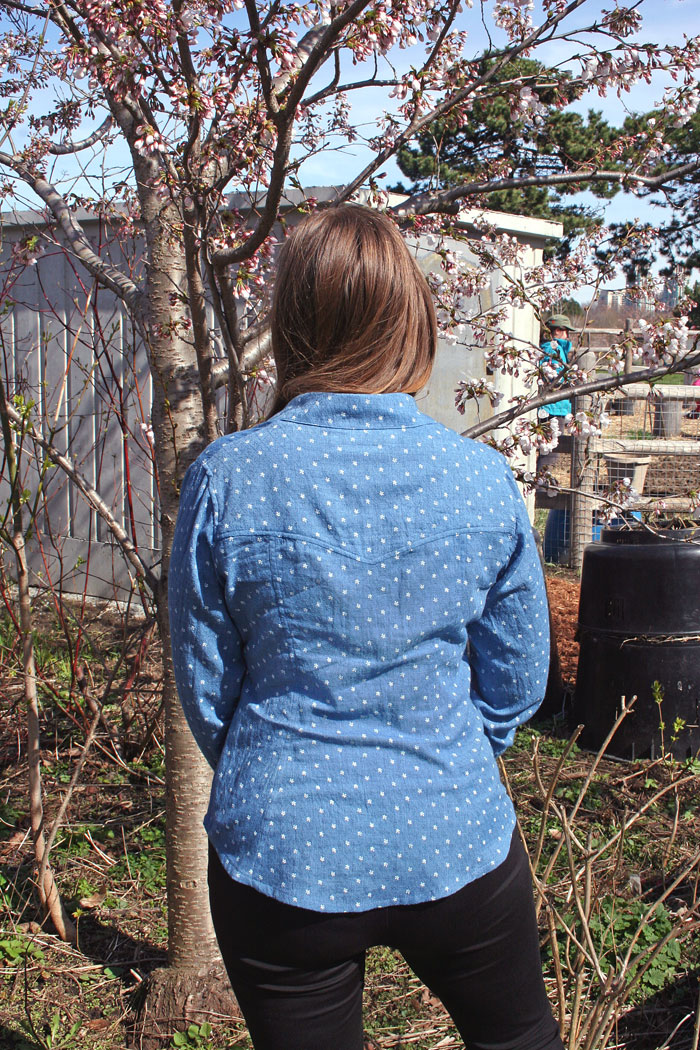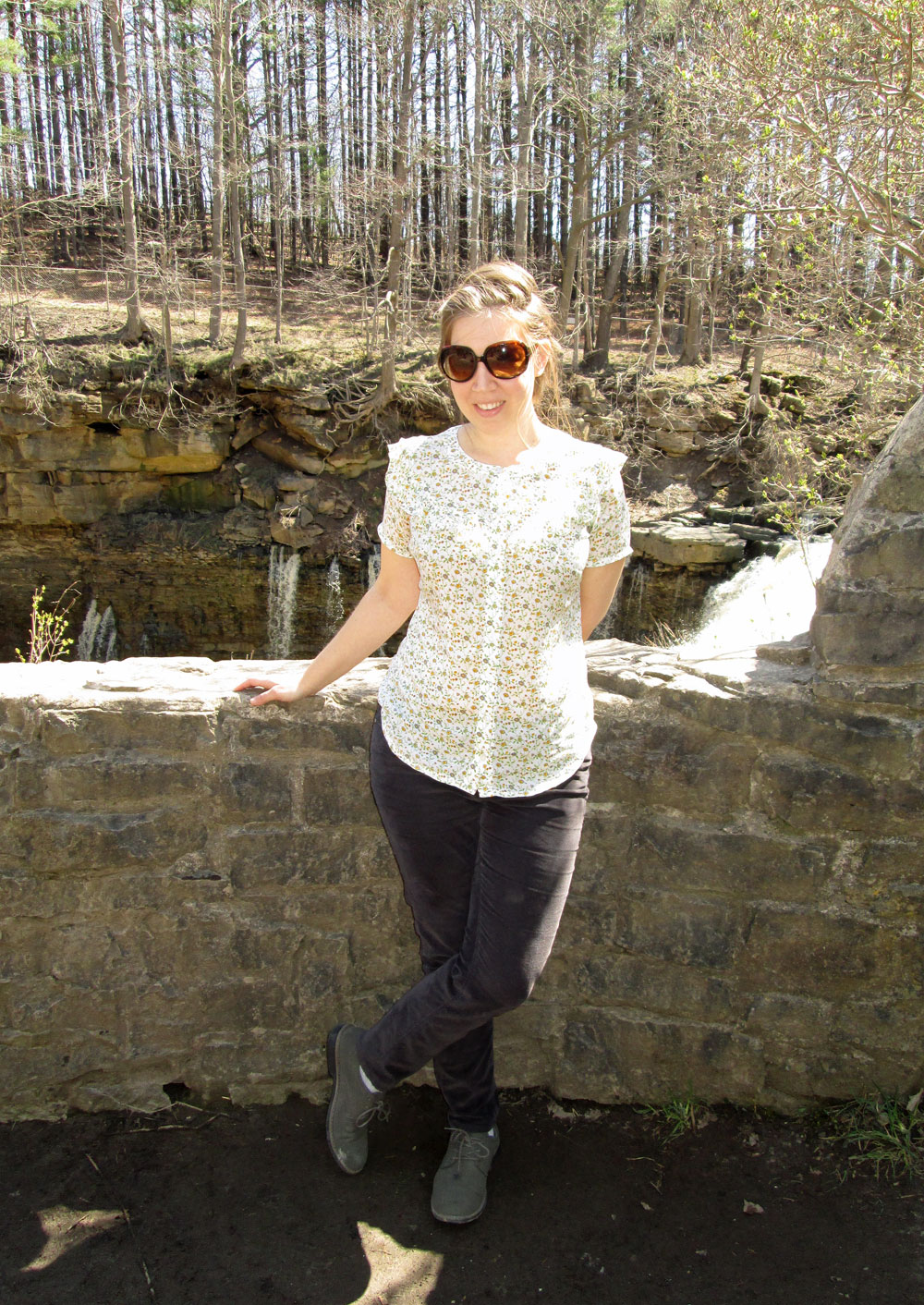I am celebrating by having finished off my new favourite coat: the Luzerne Trench by Deer & Doe! I'll be writing this post in French as well as English, since Deer & Doe is a French company and I expect many people sewing this up will be francophone.
Je fête Me Made May aujourd'hui avec mon nouveau projet terminé : le trench Luzerne de Deer & Doe patrons! J'écris cet article en français aussi qu'en anglais car D&D est une compagnie française et je pense qu'il y aura beaucoup de gens français qui voudront coudre ce patron. Excusez mes fautes--j'ai plus l'habitude de parler ni écrire en français!
What a project this was! I am thrilled with the result, but I admit that about two thirds of the way through I was dragging my heels through the remaining steps. This make is long--there are bound buttonholes (which I'd never made before), bias-bound seams, hand-sewn hems, tons of topstitching and a long belt that took forever to turn right-side-out. But I prevailed in the end!
Quel projet compliqué! Je suis ravie avec le résultat, mais j'avoue que je me suis désespérée juste après avoir terminé la moitié des étapes. Ce patron est long à coudre--il y a des boutonnières passepoilées (un technique inconnu à moi), des coutures emballés en biais, des ourlets cousus à main, beaucoup de surpiqûres, et une ceinture très longue qui m'a pris une éternité à retourner. Mais au final, j'ai réussi!
Here's the back, showing off the pleat at the waist and the lovely back belt loop detail. The pleats in the skirt give this silhouette such a full and happy shape. I made my Luzerne in beige nonstretch cotton twill from Fabricland. It was on sale for $8 so I snatched up the end of the bolt! Warning: this coat uses a lot of fabric!
Voici le dos, où on peut voir le pli à la taille et le joli passant de ceinture au centre du dos. Les plis du Luzerne rend le manteau une silhouette très ample et gaie. J'ai construit mon Luzerne de tissu beige, un sergé sans élastique, acheté à Fabricland. Il était en solde à $8 le mètre, alors j'ai pris tout le reste du rouleau! Attention: ce patron utilise beaucoup de tissu!
Here you can see the inside of the jacket with some pretty floral bias tape I made from scratch using quilting cotton. I'd never made bias tape before, and although the process is pretty straightforward (especially with one of these handy helpers), it is lengthy.
Voici l'intérieur du manteau avec le ruban biais en fleurs rose que j'ai fabriqué moi-même avec un tissu en coton. C'était la première fois que j'ai fabriqué un ruban biais, et malgré la simplicité du processus, ça prend du temps!
If I make this jacket again, I will probably use store-bought bias tape, for two reasons. First, it's faster! Secondly, and this is likely just my choice of fabric, my bias tape ended up pretty thick, and my sewing machine really struggled to get over some of the seam intersections with multiple layers of fabric and bias tape. At one point, my machine literally stopped sewing and was just beeping at me in protest.
Si je construis un autre Luzerne, je pense que j'achèterais un biais préconstruit, pour deux raisons. Un, c'est plus vite! Deux, et c'est probablement la faute de ma choix de tissu ici, mon biais fini était bien épais, et ma machine à coudre avait du mal à passer sur les coutures de nombreuses couches. Il y avait un moment où ma machine s'est arretée et ne bougeait plus à cause de l'épaisseur.
This was my first time sewing a Deer & Doe pattern, and I must say that it is beautifully drafted and everything fit together like a jigsaw puzzle. The sewing instructions were very bare-bones, so I did have to look up a few techniques, like how to bind seams with bias tape, but with the internet at my fingertips it wasn't too hard to find resources to help me with some of the steps I wasn't too sure about.
C'etait ma première expérience avec les patrons de Deer & Doe, et je suis très contente avec la qualité--tout les coutures s'alignent parfaitement. Les instructions pour la construction sont un peu maigre, donc je devais chercher sur internet comment faire quelques techniques, finir les coutures avec le biais, par example. Cela dit, c'était pas trop difficile de trouver des ressources pour m'aider.
The fit of this pattern was nearly perfect right off the bat, which was a happy surprise. My latest makes have both been from Sewaholic Patterns (my Minoru jacket and Granville shirts) and although I love the final products, both garments took a lot of pattern adjusting to fit my body properly. I was expecting to spend several days or even weeks tweaking the Luzerne pattern, but I was able to alter everything on one muslin in one evening and it fit like a dream.
La coupe de Luzerne me convient très bien--une bonne surprise! J'attendais passer des jours ou même des semaines à faire des ajustements au patron de base, mais j'ai presque rien trop changé!
Here are the changes I made:
- lowered the waist by about 3/4"
- raised the armscye for greater range of motion in the sleeves, and thereby shrunk it
- did a full bicep adjustment on the sleeves
- decreased the sleeve cap length to better fit my new armscye
- lengthened the sleeves by about an inch
- took a wedge out of the back skirt and centre back pieces at the waist, tapering to nothing at the top and bottom, to accommodate my swayback/back curvature--this worked a treat
- lengthened the belt by about 8", since a few people who've already made Luzerne said it was a bit on the short side
- lengthened the jacket overall by just drawing down to the length of the largest printed size
Voici les changes que j'ai fait au patron:
- j'ai descendu le niveau de la taille par 3/4"
- j'ai remonté les emmanchures et les ai rétrécies pour améliorer l’amplitude du mouvement
- j'ai augmenté la largeur des manches
- j'ai réduit la longueur du haut des manches pour correspondre aux nouvelles emmanchures
- j'ai rallongé les manches par environ une pouce
- j'ai enlevé un coin (une cale?) au centre des pièces du centre dos et jupe dos au niveau de la taille, pour conformer à la courbure de mon dos
- j'ai rallongé la longueur de la ceinture par 8", car quelques créatrices ont remarqué qu'elles la trouvaient un peu courte
- j'ai rallongé la longueur du manteau total
Here is a close up of the front of the jacket, where you can sort of see the bound buttonholes. The pockets in this pattern are big and deep and perfectly angled for plopping your hands right in. The welt edging on them looks super smart.
Voici le devant, où on peut voir un peu les boutonnières passepoilées. Les poches de Luzerne sont énormes et parfaitement placées pour y mettre les mains. La finition des poches est super chic aussi.
I added in one of my Dutch Label Shop tags to personalize the garment and also give it something to hang by, which I like to have in coats. I interfaced the inner facing and stitched it just to that, and as far as I can tell it is strong enough to do the job.
J'ai rajouté une étiquette de Dutch Label Shop pour personaliser le manteau et pour pouvoir le raccrocher. J'ai fusionné une triplure au revers de l'empiècement et j'ai cousu l'étiquette ici--c'est assez fort pour raccrocher le manteau, alors je suis contente.
In the photo above, you can kind of see the problem with the collar showing the underlying seam (though I did my best to pull it down for the photos). You can also see how the back yoke seam lines up perfectly with the sleeve seam--I love details like this! I actually ripped out one sleeve and re-sewed it because these seams were not lined up nicely enough for my liking.
La photo au-dessus montre un peu le problème avec le col--ça dévoile les coutures au-dessous. On peut voit ici aussi comment les coutures des manches s'alignent parfaitement avec les coutures de l'empiècement au dos--j'adore des détails comme ça! En fait j'ai recousu une des manches pour parfaire cet alignement.
Not everything went smoothly for me during this project. As I said above, my sewing machine protested at going over the thicker seams, especially when it came to topstitching. The topstitching thread was so thick, that even with my jeans needle, everything felt a bit tight and the stitches kept skipping over thicker areas.
I also had a problem with my inner yoke facing piece not lining up perfectly with the outer yoke piece, so on the inside, the line of stitching does not line up with the edge of the yoke and looks kind of weird. I took a crappy cell phone photo of this, so you can see what I mean:
Pas tout s'est bien passé avec ce projet. Comme j'ai dit, ma machine à coudre avait un peu de difficulté avec les coutures épaises, particulièrement avec les surpiqûres. L'empiècement à l'intérieur n'a pas bien correspondu avec celui de l'extérieur, alors la ligne de coudre n'est pas très beau à l'intérieur. J'ai pris une photo avec mon mobile (mauvaise qualité!) pour montrer cela:
These photos were taken at University College, on the campus of UofT. It's such a lovely old stone building and makes a great backdrop for photos. The weather has been horrible and rainy, but today was lovely so I wanted to take advantage while I could!
Ces photos étaient prises à University College, au campus de l'Université de Toronto. C'est un bel immeuble en pierre et ça marche bien comme arrière-plan pour des photos! Ces derniers jours, le temps à Toronto ne faisait pas trop beau, alors il fallait m'en profiter du soleil aujourd'hui!
Overall, I am beyond happy with this coat. I've been lacking a nice, basic piece like this and I was overjoyed when Deer & Doe released this pattern. It really is the loveliest silhouette and so worth it in the end, even though it's a big project.
Au final, je suis plus que ravie avec ce monteau. Je manquais un manteau joli et classique comme cela et quand j'ai vu le patron au début, je savais que j'en avais besoin! Vraiment la silhouette est trop flatteuse et ça vaut la peine de le fabriquer, même si c'est long à faire.





























































